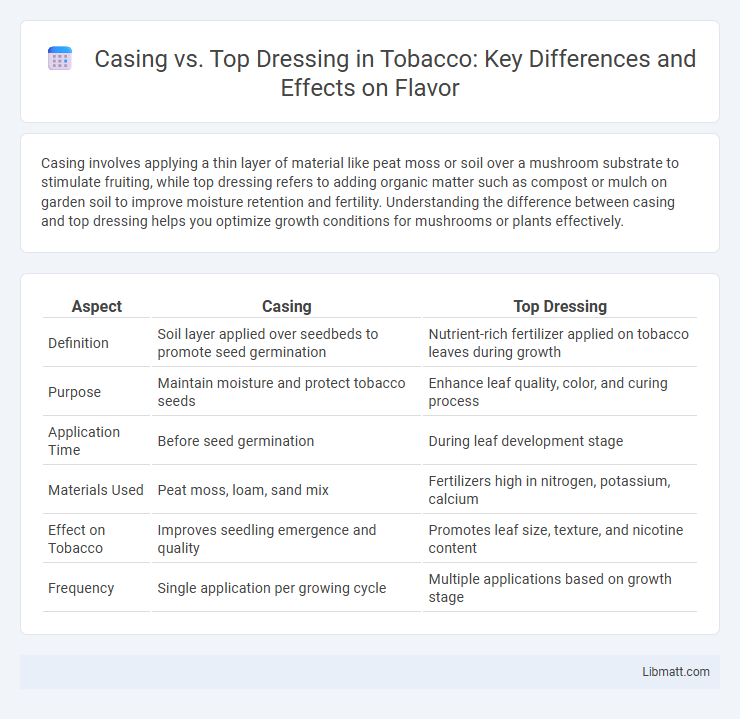Casing involves applying a thin layer of material like peat moss or soil over a mushroom substrate to stimulate fruiting, while top dressing refers to adding organic matter such as compost or mulch on garden soil to improve moisture retention and fertility. Understanding the difference between casing and top dressing helps you optimize growth conditions for mushrooms or plants effectively.
Table of Comparison
| Aspect | Casing | Top Dressing |
|---|---|---|
| Definition | Soil layer applied over seedbeds to promote seed germination | Nutrient-rich fertilizer applied on tobacco leaves during growth |
| Purpose | Maintain moisture and protect tobacco seeds | Enhance leaf quality, color, and curing process |
| Application Time | Before seed germination | During leaf development stage |
| Materials Used | Peat moss, loam, sand mix | Fertilizers high in nitrogen, potassium, calcium |
| Effect on Tobacco | Improves seedling emergence and quality | Promotes leaf size, texture, and nicotine content |
| Frequency | Single application per growing cycle | Multiple applications based on growth stage |
Introduction to Casing and Top Dressing
Casing involves applying a thin layer of nutrient-rich material over the surface of a growing medium, promoting optimal moisture retention and mycelium development in mushroom cultivation. Top dressing refers to the practice of adding a fresh layer of substrate material on top of the existing casing layer to enhance fruiting body growth and yield. These techniques play a crucial role in optimizing mushroom productivity and maintaining a conducive environment for your crop's development.
Definition of Casing
Casing is a thin layer of soil or organic material applied over mushroom spawn to create a microenvironment that supports fruiting body development. This protective layer helps retain moisture and provides a medium for the mycelium to grow, differentiating it from top dressing, which is primarily used for fertilization or pest control in gardens and lawns. Understanding casing's role is essential for optimizing your mushroom cultivation process.
Definition of Top Dressing
Top dressing involves applying a thin layer of soil, compost, or other organic material over the surface of soil or turf to improve soil quality, nutrient content, and moisture retention. Unlike casing, which is a specific medium applied to mushroom substrates to promote fruiting, top dressing enhances plant growth by enriching the existing soil environment. You can use top dressing to boost lawn health, garden beds, and agricultural fields by providing an immediate nutrient source and improving soil texture.
Key Differences: Casing vs Top Dressing
Casing involves applying a thin layer of moist material, such as peat moss or vermiculite, directly on mushroom substrate to retain moisture and promote fruiting, whereas top dressing uses a nutrient-rich soil or compost layer to enhance plant growth in gardening or landscaping. Casing does not provide nutrients but creates an ideal microenvironment for mushrooms, while top dressing supplies essential nutrients and improves soil fertility for plants. The main difference lies in their purpose: casing is specific to mushroom cultivation for moisture retention and fruit body development, whereas top dressing primarily supports plant nutrition and soil health.
Benefits of Casing in Cultivation
Casing in cultivation enhances moisture retention and protects the substrate from contamination, promoting robust mycelium growth and higher yield quality. Unlike top dressing, casing layers provide a microenvironment that regulates humidity and gas exchange, crucial for optimal fruiting body development. Your cultivation process benefits from improved crop uniformity and reduced washing-off of nutrients, making casing a valuable technique for sustainable mushroom production.
Advantages of Top Dressing Techniques
Top dressing enhances soil fertility by evenly distributing nutrients and organic matter, improving plant growth and yield more effectively than casing. This technique promotes better moisture retention and reduces soil erosion, resulting in healthier root development and increased crop resilience. Top dressing also facilitates targeted nutrient application, minimizing waste and environmental impact while boosting overall soil health.
When to Use Casing Layers
Casing layers are essential during mushroom cultivation when nurturing mycelium before fruiting, providing moisture retention and protection against contaminants. Use casing layers after the spawn run is complete and the substrate is fully colonized to trigger pinning and enhance mushroom yield. Unlike top dressing, which is added during or after fruiting to provide nutrients, casing layers create an optimal microenvironment early in the growth cycle for successful mushroom development.
When to Apply Top Dressing
Top dressing should be applied during the active growing season when your lawn or turf is healthy and actively growing, typically in the spring or early fall. This timing allows the nutrient-rich material to integrate smoothly with the soil, improving soil structure and promoting vigorous root development. Applying top dressing too early or too late can hinder absorption and reduce its effectiveness compared to casing, which is used primarily at planting or seeding stages.
Common Mistakes with Casing and Top Dressing
Common mistakes with casing include applying it too thickly, which can suffocate thread spawn and slow mycelium growth, or using contaminated casing material that introduces harmful pathogens. In top dressing, uneven application or using inappropriate materials can lead to poor moisture retention and inhibit mushroom development. Ensure your casing and top dressing layers are properly balanced and free of contaminants to promote healthy and productive mushroom cultivation.
Conclusion: Choosing the Right Method
Casing provides a nutrient-rich layer that promotes uniform mushroom growth and enhances spawn colonization, making it ideal for small-scale or precision cultivation. Top dressing offers a simpler, less labor-intensive approach, suitable for larger operations where maintaining moisture and extending fruiting cycles are priorities. Your choice depends on balancing the need for control and yield quality against ease of application and scale of production.
Casing vs top dressing Infographic

 libmatt.com
libmatt.com